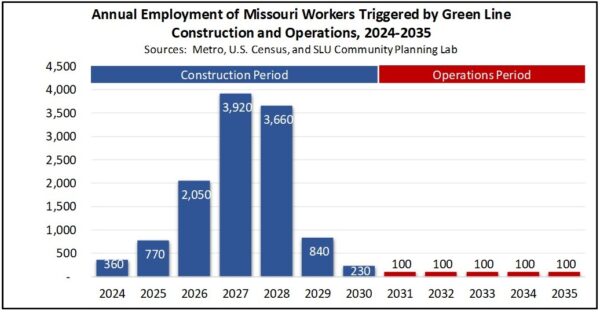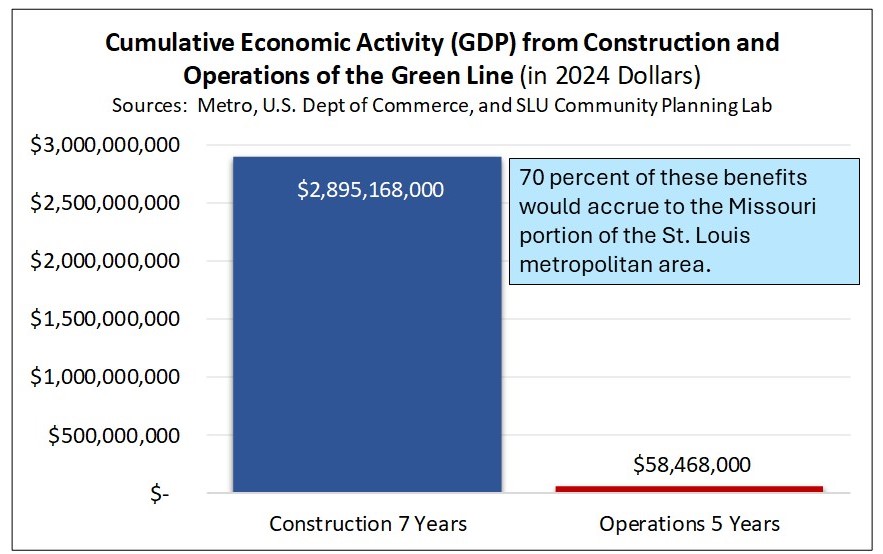 First Five Years of Operations Expected to Generate $58.5 Million in Statewide Economic Activity
First Five Years of Operations Expected to Generate $58.5 Million in Statewide Economic Activity
Investment in public transit accessibility extends beyond simply getting people where they need to go. It also serves as a catalyst for significant economic returns. To help underscore this, the St. Louis region’s transit advocacy organization Citizens for Modern Transit has released findings of a study commissioned to quantify the projected economic impacts of the St. Louis MetroLink Green Line. The Projected Green Line Economic Impacts 2024-2035 projects that construction of the St. Louis MetroLink Green Line will have an overall economic impact of $2.9 billion and an additional $58.5 million in statewide economic activity will be generated within the first five years of operation,
“The price tag associated with the development of the St. Louis MetroLink Green Line is significant,” commented Kimberly Cella, executive director of Citizens for Modern Transit. “It is imperative that area leaders, stakeholders, transit riders and the community at-large better understand the ripple effects of an infrastructure investment of this magnitude. The projected impacts cannot be understated – it would be a huge win for the region.”
The “STL MetroLink Green Line Projected Economic Impacts” study was prepared by Saint Louis University Community Planning Lab within the Department of Earth, Environmental and Geospatial Science of the School of Science and Engineering in conjunction with Robert M. Lewis, FAICP, CEcD. It projects direct and multiplier economic impacts triggered by construction and operations spending for two different periods, including construction during the seven calendar years of 2024 to 2030, and the first five years of operations from 2031 to 2035. The current Missouri economy serves as the basis for all impact projections as all dollar amounts are in 2024-dollar values.
The study revealed the projected impacts the St. Louis MetroLink Green Line would have on statewide economic activity, household earnings and jobs during construction and once operable.
Construction
Over the seven years of projected construction the STL MetroLink Green Line would generate:
- An annual average of nearly $413.6 million in economic activity in the Missouri economy, resulting in a cumulative impact of nearly $2.9 billion.
- An annual average of more than $121.6 million in additional household earnings for Missourians, resulting in a cumulative impact of more than $850 million.
- An annual average of 1,690 jobs over seven years with a peak of 3,920 jobs in 2027.
Operations
During the first five years of operations the STL MetroLink Green Line would generate:
- An average of nearly $11.7 million in statewide economic activity per year, resulting in a cumulative total of $58.5 million.
- An annual average of $5.6 million in additional household earnings, resulting in a cumulative total of $28 million.
- An annual average of 100 direct and indirect jobs.
“It is important to note that 70 percent of the statewide economic impacts of the St. Louis MetroLink Green Line would be experienced in the St. Louis metropolitan area,” stated Robert M. Lewis, FAICP, CEcD, who led the study. “This is a direct impact of $2.03 billion during construction, with another nearly $41 million during the first five years of operation, on the local economy.”
“Not only will the MetroLink Green Line project generate economic development, but it will help make St. Louis more competitive and attractive to new businesses and residents” said Taulby Roach, Bi-State Development President and CEO. “This is how we change the fabric of our region. Our citizens can enhance how they get to work, learn, and play.”
This proposed St. Louis MetroLink Green Line alignment is set to include 10 stations and 5.6 miles of in-street light rail running from Jefferson Avenue at Chippewa Street in South St. Louis to Natural Bridge Avenue in North St. Louis, while connecting with the current MetroLink system via a transfer station. This would provide a vital link between North and South St. Louis City, connecting an estimated 5,500 residents a day to growing job centers in Downtown West and Midtown, educational opportunities and healthcare services. It has been designed to preserve and enhance existing neighborhoods, deliver equitable access to jobs, promote unity, achieve regional objectives, reinforce existing public and private investments and provide improved transportation for area residents.
“The project development application has been given the green light by the Federal Transit Administration,” added Cella. “If awarded, this will enable the request of federal funding to cover up to 60 percent of the total project costs, potentially bringing as much as $600 million back to the St. Louis region for capital expansion.”
To learn more about the St. Louis MetroLink Green Line, visit https://MetroLinkGreenLine.com/.
